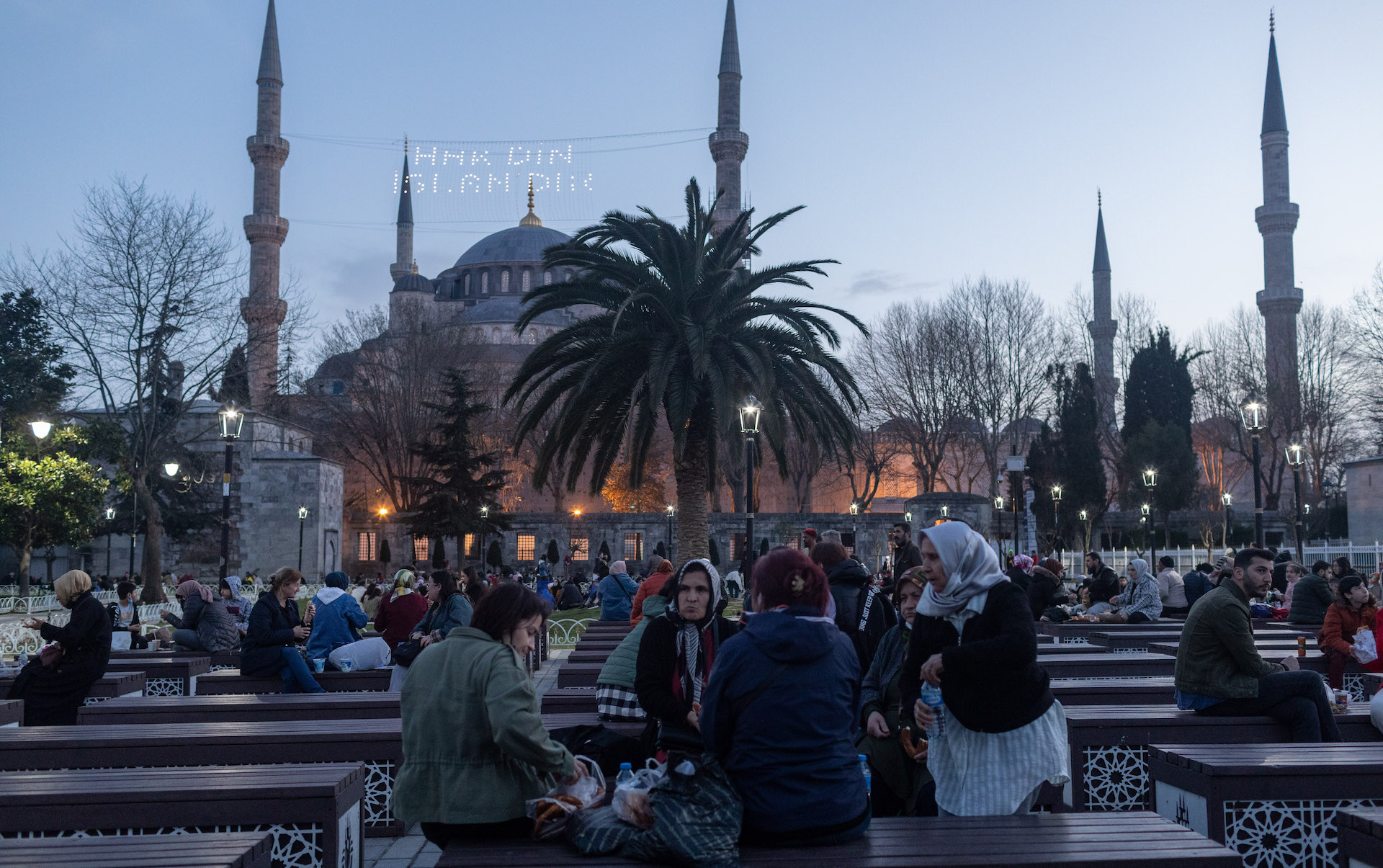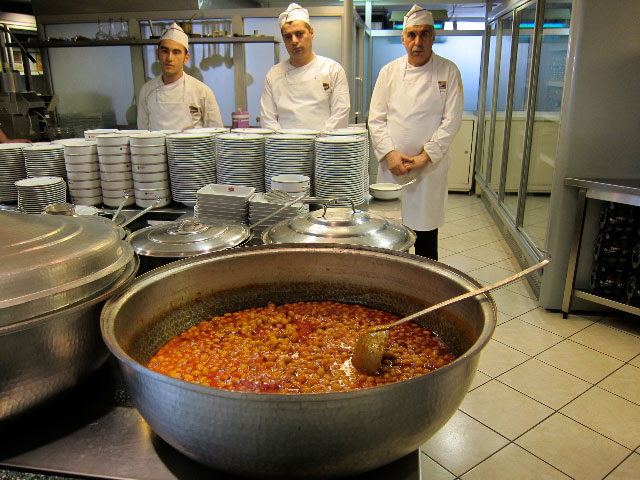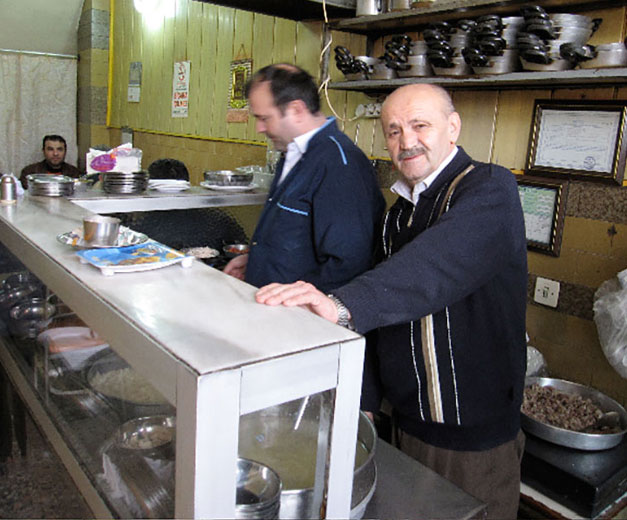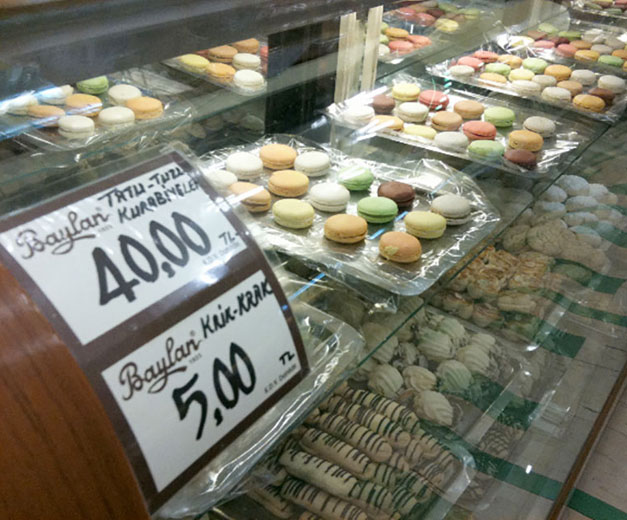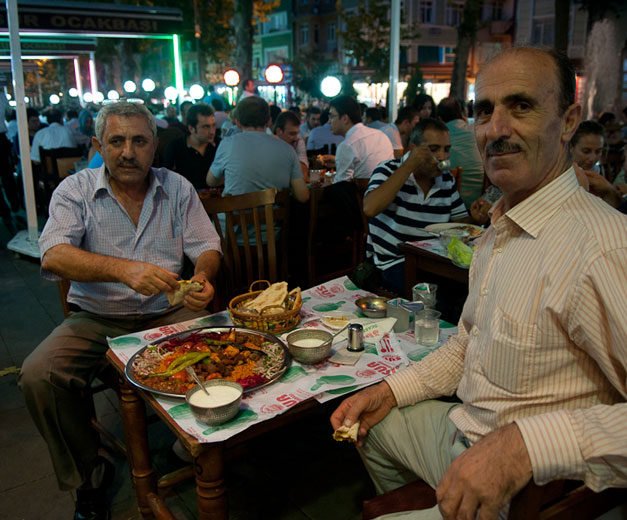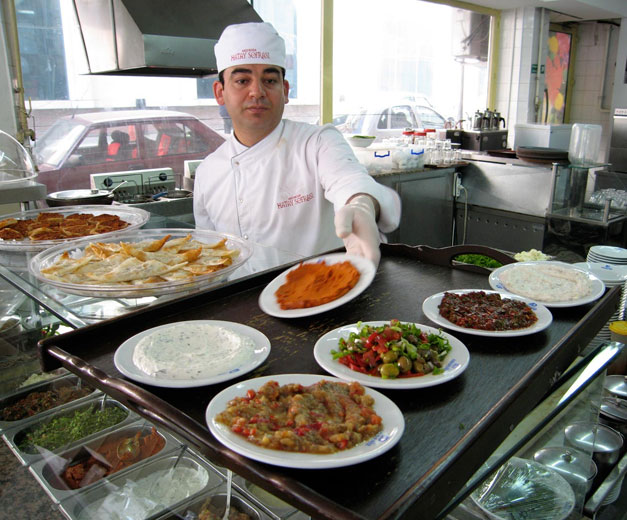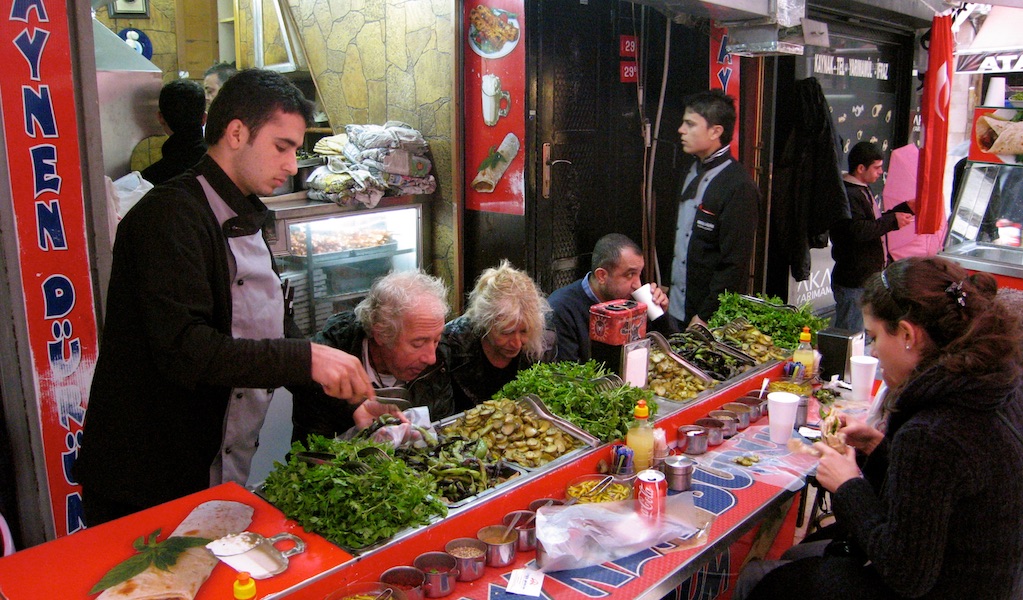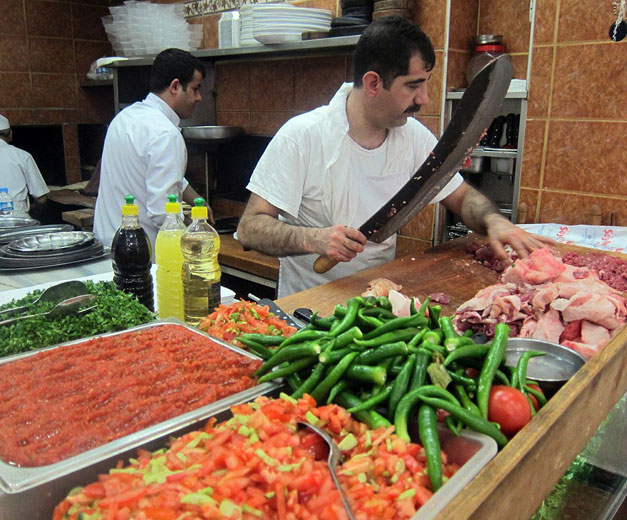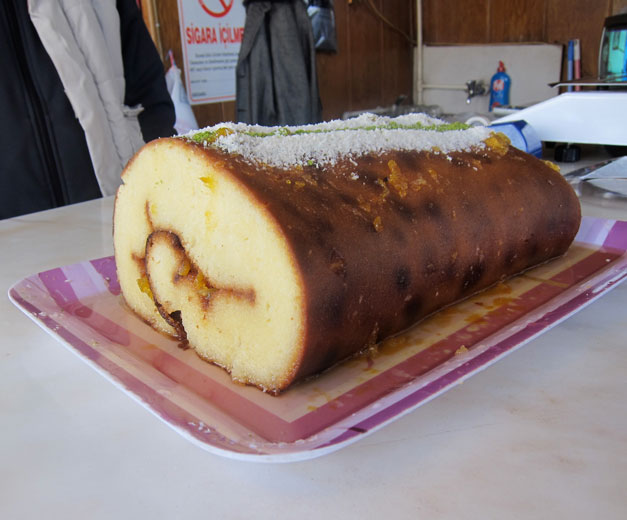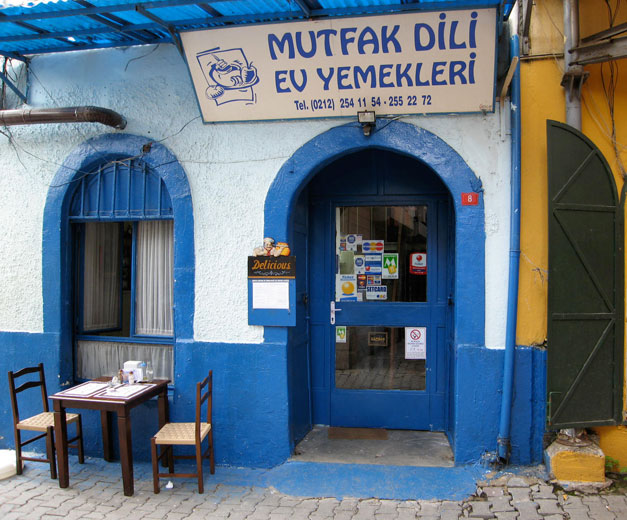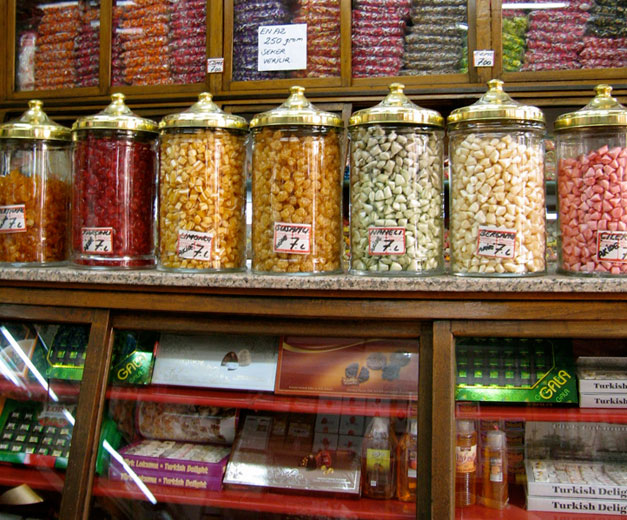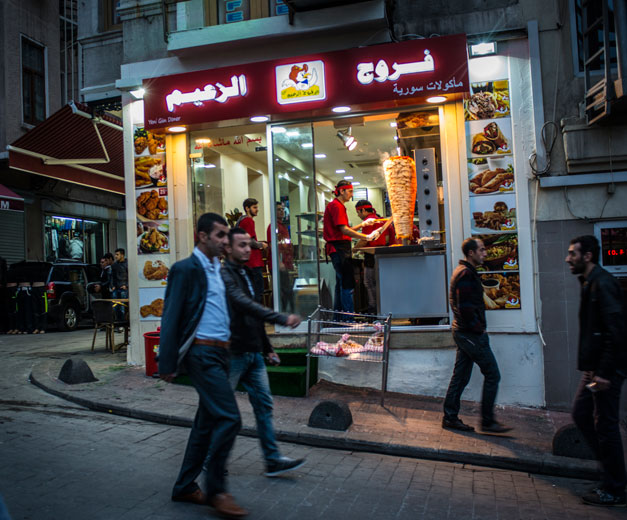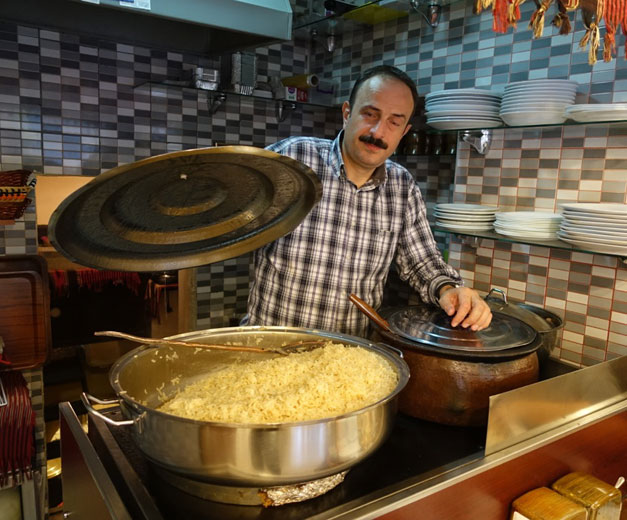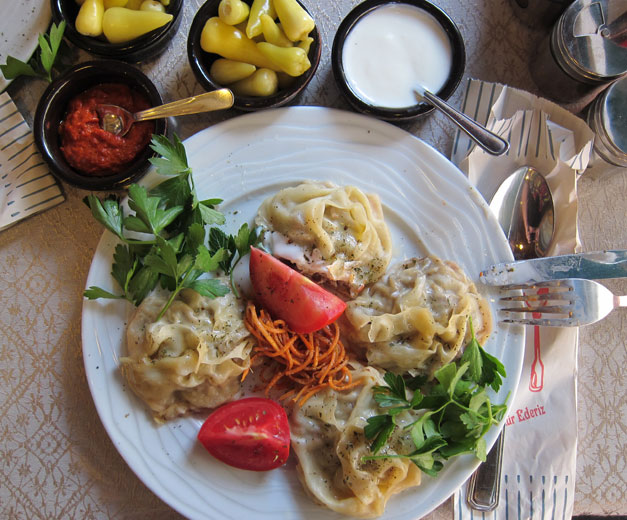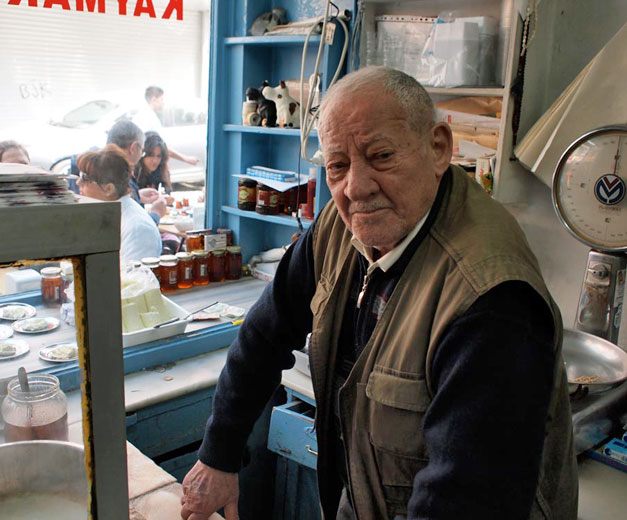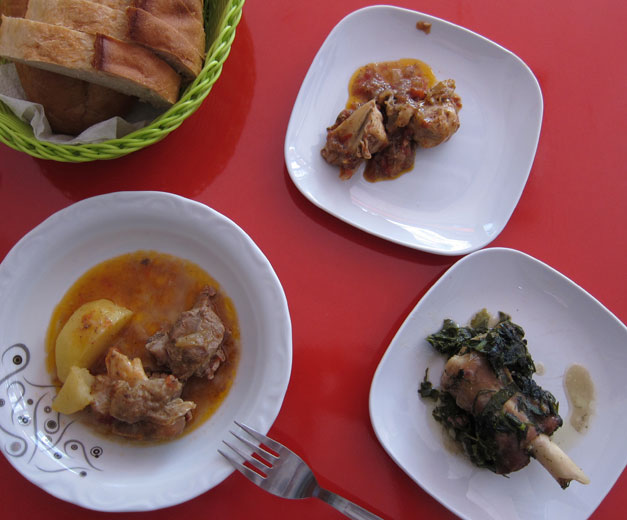We can't find the internet
Attempting to reconnect
Something went wrong!
Hang in there while we get back on track
Search results for "istanbul eats"
Istanbul
Sultanahmet Dining Secrets: Where Locals Dare to Go
Call it the Sultanahmet Squeeze: How to stay close to the monuments of the Old City yet avoid eating in tourist traps? We get asked this question a lot. Since the Sultanahmet area is primarily a tourism zone, locals-only haunts are few and far between. At most restaurants, prices tend to be higher than usual, while quality and service are unreliable at best. That said, there are some fine places to eat in the area. We’ve compiled a short list of restaurants to help you avoid the traps.
Read moreIstanbul
Çukur Meyhane: When Liver Met Hamsi
Çukur Meyhane, a small, slightly shabby basement meyhane in Beyoğlu’s Galatasaray area, certainly does not look like the kind of place with any shining stars on the menu. On one of our very first visits, the floor seemed to be covered in a mixture of sawdust, table scraps and some cigarette ash. The tiny open kitchen occupies one corner, while the VIP table – where a group of old-timers can be found watching horse races on TV, scratching at racing forms, cursing and cheering – takes up a slightly larger area. A good bit of the other half of the room is home to a giant ornamental wooden beer barrel.
Read moreIstanbul
Bean Week: Istanbul's Top 5 Beaneries (Updated)
Istanbul’s eaters are spoiled by opportunities to eat great beans – and in the Turkish kitchen that means white beans, in particular, and if you’re lucky, the şeker fasulye type grown in Eastern Turkey’s İspir region. We’ve tried countless subtle variations on roughly the same recipe and, wiping mouth on sleeve after a bowl, declared that we could eat beans every single day of the week. We’ve spent a lot of time comparing almost identical-tasting Black Sea-style beans and hunted down those that are harder to categorize. Taking part in the bean discourse is a great pleasure of ours and we are not alone in doing so. Turkish newspapers regularly run features analyzing the baked bean, featuring inserts ranking the best beans, nationally, by a panel of judges. It’s a gas. In this roundup we’ve compiled our favorite beans in different styles. Though the gold standard achieved by standouts Hüsrev and Fasuli is widely agreed to be the best in show, we’ve included a couple of quirky beaneries in our list of favorites, because, in reality, you can’t eat the same beans every day.
Read moreIstanbul
Öz Kilis: Kebab That Deserves to Be Panned
In Turkish popular lore, the residents of Kilis, a town in Southeast Turkey near the Syrian border, are known for two things: kebab-making and smuggling. We haven’t been to Kilis, so we can’t vouch for the smuggling bit (although these days the town is featured regularly in the headlines as a hub for fighters being hustled across the border into Syria). But based on the food we’ve tried at Öz Kilis, a wonderful little spot on a quiet backstreet in Fatih run by two Kilis natives, we can report that the kebab-making reputation is well-deserved. Not just any kebab, mind you. Clearly an unorthodox and clever lot, the people of Kilis have a distinctly different approach to cooking meat. While a wide swath of humanity stretching from the Balkans to the Hindu Kush makes their kebabs by putting meat on a skewer and cooking it over a fire, the people of Kilis are famous for their “pan kebab,” a thin disc of ground meat that is cooked in a shallow metal dish that’s put in the oven.
Read moreIstanbul
Özbek Sofrası: A Higher Plov
In the former Soviet Central Asian republics, the boilerplate restaurant menu consists of plov, lagman, shashlik and samsa. Tired-looking Uzbek, Kyrgyz, Kazakh and Tajik establishments all serve up the same limp noodles and oily rice with a shrug – it’s their job. In the markets of Samarkand, Osh and Almaty, we found some exciting exceptions to this rule but, generally, restaurants in the region tend to successfully obscure the fact that Central Asian food, when cooked with passion, can be a riot of the senses. In Central Asia, according to regional specialist Sean Roberts, culinary traditions have customarily been preserved by a master/apprentice system that mainly existed outside restaurants. Monumental occasions like weddings and funerals in Uzbekistan often involve several hundred guests eating multiple meals. For this, an usta is called in from his day job, like Clark Kent from the newsroom.
Read moreIstanbul
Hail Caesar's: Mushroom Hunting in Istanbul's Forests
Editor's note: We're celebrating Mushroom Week at Culinary Backstreets, and today's installment takes us to Istanbul's Belgrade Forest, where Turkey's leading wild mushroom expert has found some remarkable fungus specimens. “This would be front-page news in France!” Jilber raved, darting off between tall chestnut trees and oaks, obscured by a hazy steam that seemed to hang in the forest like a gauzy Halloween decoration. He looked over each shoulder and all around him where it seemed he was surrounded by golf balls, shanked off and forgotten in the rough.
Read moreIstanbul
Kristal Ocakbaşı: The People's House
Outside of Kristal Ocakbaşı, a small grill joint tucked away on a side street in the Pangaltı neighborhood, Obama sat greeting the regulars who streamed in to watch a soccer game while feasting on kebab. “What’s the news, Obama?” asked one man with shoulder-length white hair. “Selam aleykum, Obama,” said another. One woman patted him on the head and baby talked to him, calling him by the affectionate nickname “Obiş.” Though we’d never heard such fond regard for the American president, Obama – the tanker-sized street dog of Eşref Efendi Sokak – took it in stride, yawning lazily. It was just another Monday night among his adoring constituents.
Read moreIstanbul
Big-Time Baklava: The Best Spots for Gaziantep’s Renowned Sweet
Editor’s note: To celebrate Ramazan Bayramı, also called Şeker Bayramı, the three-day holiday at the end of the holy month of Ramadan, we are republishing this 2014 article about our favorite spots for baklava – sweets are an integral part of the festivities, which began on May 13 this year. Turkey’s European Union membership bid may be stuck in the mud, but a different dynamic is at work on the food front. To wit: the European Commission has granted Gaziantep baklava a spot on its list of protected designations of origin and geographical indications. It’s the first Turkish product and the 16th non-EU food to make it on the list. In honor of this much-deserved recognition, we’ve put together our own list of favorite places to get baklava in Istanbul and Gaziantep.
Read moreIstanbul
Erzincan Tandır Ekmeği: Village Loaves for City Folks
In the Kurtuluş district of Istanbul, we’ve lately been exploring links to older, nearly lost Istanbul culinary traditions. Spending time in the sweetshops, milk bars and şarküteri of this district, we’ve seen a glimmer, if faded, of the “Old Istanbul” that people remember from the 1950s and '60s, when the city’s historic minorities – Greeks, Armenians and Jews – played a prominent role in the culinary scene of the city. It’s a complex and endlessly fascinating subject, one that never fails to spark our curiosity. And then we were distracted by the smell of fresh bread. Fresh lavaş, to be more specific, being hoisted out of a fiery hole in the floor on a blackened hook by the sturdy Gül Hanım.
Read moreIstanbul
Kenan Usta Ocakbaşı: Skewers at an Exhibition
If Istanbul had a city museum, in the 20th-century exhibition we’d expect to walk into a life-sized recreation of Kenan Usta Ocakbaşı, a seminal grill joint in the Beyoğlu district. As visitors descended a few steps into the exhibition, sensors would trigger the harsh light of fluorescent bulbs overhead, illuminating a room covered in photographs of husky men with mustaches posing with a stout man in an apron, grill master Kenan Usta. The somber, groaning warble of the great Arabesque singer Müslüm Gürses would cue up in the visitors’ rented headsets and ducts inside the replica grill would belch out smoke scented authentically by grilled meat.
Read moreIstanbul
Bodrum Mantı: Turkish Dumpling Delight
From Western China all the way to Istanbul, Turkic people roll out dough, fold it into small pouches, boil it and call it mantı. When it comes to dumplings, Turkish tradition dictates that the tortellini-like mantı be no larger than peanut-sized. With its unusually large (and sometimes fried) dumplings, Bodrum Mantı & Café has taken traditional Turkish mantı to soaring new heights, of which we strongly approve.
Read moreIstanbul
“I’ve Come and I'm Gone”: A Tribute to Istanbul’s Street Vendors
Metin Akdemir is a filmmaker based in Istanbul. In 2011 he made a short film about street vendors in the city. The film, “Ben Geldim Gidiyorum” (“I’ve Come and I’m Gone”), won several awards in Turkish and international film festivals, and we think it’s a very valuable piece of work that captures a side of Istanbul’s culture that is slowly disappearing.
Read moreIstanbul
Best Bites 2015: Istanbul
Editor’s note: To give 2015 a proper send-off, we’re taking a look back at all our favorite eating experiences this year. Hamo’nun Yeri The nohut dürüm, a simple wrap of mashed chickpeas, peppers, parsley and spices, may be a popular breakfast choice in certain districts of the southeastern province of Gaziantep, but we'll eat it anytime and are prepared to travel far and wide to do so, as this treat is by no means common in Istanbul. Hamo'nun Yeri is located in Güngören, a densely packed working-class district located well outside the radar of tourists and more affluent Istanbulites. Made with bread hot out of the oven from the family's bakery down the block, the dürüm – and a chat with the friendly Gül brothers – is more than worth the trip. Address: Güngören Merkez Mah., İkbal Sokak 9/B, Köyiçi Telephone: +90 535 016 0316 Hours: 7am-10pm —Paul Osterlund
Read moreIstanbul
Mari: The Cosmopolitan
Editor's note: The chef and owners of Mekan have moved on to a new location, which they've named Mari. We're sorry to report that Mekan itself has since gone downhill. In the great multicultural Anatolian kitchen, questions about the ethnic or national origins of foods are often cause for forks and knives to fly. A porridge called keşkek is a hot-button diplomatic issue between Turkey and Armenia, and we won’t even get started on the ongoing baklava debate. So what to make of this cuisine that draws influences from every corner of the former Ottoman lands, a territory stretching from the Balkans to North Africa? The answer might be in a simple term that’s becoming popular among Turkey’s minorities. The word Türkiyeli means “of Turkey” and differs significantly (and quite intentionally) from the word Türk, which often adds ethno-religious shades to nationality.
Read moreIstanbul
Osman’s Truck:
We generally wouldn’t recommend pulling yourself up into the back of a broken-down truck with no license plates that’s sitting in an empty lot down by the river, but Osman’s truck offers a rare glimpse of Istanbul if there really were no rules, and, not to mention, great views of the Golden Horn. In the back of Osman’s truck, with the winter sun reflecting off of the Golden Horn just 20 feet from the hitch, the subject of discussion on a recent afternoon was freedom. “Commerce has ruined the free spaces, the nature within this city,” said Osman from behind the counter, located in the back of the covered truck’s cargo area, now converted into a cozy café, with low tables and padded benches. “There’s no pleasure in it!” added Mehmet, whose role here seemed to fall between maitre d’ and mascot.
Read moreIstanbul
A (Shady) Place in the Sun:
Summer months in Istanbul can be oppressively hot. In a city that seems more prone to laying asphalt than planting trees, a public place in the shade is hard to find. Though many Istanbulites escape to the green spaces outside of the city on weekends, we’ve compiled a few inner-city options for the urban picnicker looking for a break from the heat. First you’ll have to assemble the picnic basket. For its bountiful shopping options and convenience, we suggest doing so in the Cihangir neighborhood of Beyoğlu. In addition to a Carrefour supermarket, which is useful for certain picnic essentials, this area also has a few gourmet shops and fruit stands that easily fill the basket.
Read moreIstanbul
Baba Söğüş: 100% Organ-ic
The story starts with two successful business executives, dreaming of a drastic change in their lives. They turn to what they love, eating, and find a gaping hole in Istanbul’s restaurant scene. Until just a few years ago, you’d know where this story was heading – a research trip to Naples or Bangkok, followed by the opening of a limp pasta restaurant in the environs of İstinye Park or some other upscale shopping mall. But not this time. The heroes of our story set their sights on the city of Izmir and its offal-laden cuisine. Izmir folk love kelle söğüş (boiled sheep’s head, served cold) and kelle tandır (a roasted version). While in Istanbul these specialties are largely a novelty, in the busy downtown markets of Izmir you’re more likely to come across kelle than kebab. Your friends from Izmir will never post a photo of a sheep’s head on their Facebook page with a freaked-out-looking emoticon because, to them, tucking into a sheep’s head lunch is just everyday business as usual. And, in Istanbul, it seems, the Izmir way of lunch could be catching on.
Read moreIstanbul
The Salepçi of Sütçüler: The Hard Life of a Sweet Trade
By the name of the place, you’d expect the Sütçüler (“Milkmen” in English) district near Isparta in southern Turkey to be a dairyland paradise, thick on the ground with men carrying buckets sloshing fresh milk, cheese wheels stacked in cool dark sheds, verdant hills freckled with cows. But there are no milkmen in Sütçüler, at least not in the wintertime. The area’s name actually has nothing to do with anything going on in Sütçüler itself.
Read moreIstanbul
Ceyhan Ocakbaşı: Wings of Industry
In many parts of Istanbul, it’s not unusual to reside amidst industry in progress. It could be a workshop in your building’s basement where fire extinguishers are refilled, a copper pot re-tinning enterprise just outside your front door or a knockoff Fendi purse assembly line you catch a surprising glimpse of as you look across the breezeway into an adjacent building. Despite zoning laws, the age-old tradition of living alongside the clang of the forge and the whir of heavy instruments is still a reality in Istanbul. And as hard as it may be to weed out all of these workshops, efforts over the past 40 years to do so are not without results.
Read moreIstanbul
İnciraltı: Meyhane Time Machine
We like to think of İnciraltı, a laid-back meyhane in the sleepy Bosphorus-side Beylerbeyi neighborhood, as a destination restaurant – not so much because of the food, but because of the destination itself. Not that there’s anything wrong with the food here, which is reliably well made. The meze tray at İnciraltı (which means “under the fig tree” in Turkish) is brought to your table carrying all the classics, plus a few welcome and tasty surprises, such as the zingy brined twigs of the caper plant and a sea bass fillet that has been cured in a piquant sauce redolent of curry.
Read moreIstanbul
Sıdıka: Last Night a Meze Saved Our Lives
It has been years now since we were first tipped to Sıdıka. The W Hotel had just opened in the splashy Akaretler rowhouse development. Vogue, the rooftop sushi lounge, was still in style. The Shangri-La hotel was under construction down on the waterfront, and it was rumored that some rooms would have Bosphorus views below sea level. Beşiktaş, long the bastion of cheap draft beer joints and university student flatshares, was having some growing pains.
Read moreIstanbul
CB Book Club: Aylin Öney Tan’s A Taste of Sun & Fire
For many (us here at Culinary Backstreets included), the city of Gaziantep is without a doubt the culinary mecca of Turkey. Located not far from Turkey’s southern border, a meeting point between the Arab Middle East and Turkish Anatolia, Gaziantep over the centuries has developed a culinary culture that is deeply rooted in the rhythm of the agricultural lands surrounding it and that is maintained with great pride and honor by the city’s cooks and food makers. Gaziantep is also the source for many of Turkish cuisine’s iconic dishes – the city’s famous baklava is without compare and its kebabs are truly works of art, the standard by which all others are measured.
Read moreIstanbul
Kelle: Face Off
Don’t people just love to fight about food? Punch-ups over which city makes the best pizza, brawls about what’s the right way to barbecue. Louis and Ella nearly called the whole thing off over the pronunciation of the word “tomato.” In this pugilistic spirit, we took our place at a couple of stools at our favorite back of the fish market corner bar, Asmaaltı, from which to call one of the great barroom debates of these parts: Is a sheep’s head, or kelle, more tasty when boiled and served chilled or roasted and served hot?
Read moreIstanbul
Cuma Usta: Anatolian Snow Cone
Standing behind the counter at his small bici bici shop in Gökalp Mahallesi, a neighborhood in the Zeytinburnu district of Istanbul, Cuma Usta recalls the first time he headed up into the mountains with his uncles in search of wild ice, one of the key ingredients in this Turkish snow cone treat sold from street carts throughout southern Turkey. His uncles had gone up in the winter and cut large slabs of ice from the mountaintop, wrapped it in old blankets and hauled it off with a donkey to a nearby cave. In July, with young Cuma – just being introduced to the ways of bici bici – in tow, they headed back to the cave to collect the ice. It took a couple of hours by car, as he recalled, and the ride back to Adana, vehicle loaded with the frozen bounty, was nice and chilly. Then they’d use that ice to make the summertime street food favorite bici bici (pronounced like the disco-era band of brothers from Australia) and sell it from pushcarts. According to tradition, a bici bici master is, firstly, a harvester of ice.
Read moreIstanbul
Kısmet Muhallebicisi: Funky Chicken
Ali Bey, the owner of a cubby-sized restaurant in Küçük Pazarı called Kısmet, sounded a bit like Bubba Gump listing the items on his menu: “We've got chicken soup, fried chicken gizzards, shredded chicken breast, dark chicken meat too, chicken and rice, chicken with onions and peppers, and chicken breast pudding for something sweet.”
Read moreIstanbul
Baylan Pastanesi: A Slice of History
The roaring '20s: Flappers in the Pera Palas Hotel were dancing the can-can, Art Deco was all the rage, the Turkish Republic was born. Hope, progress and newness double-stepped to the beat of Kemal Atatürk’s drum. This was the backdrop to which two Istanbul bakers, Filip and Yorgi, opened a whimsical chapter in the culinary story of the city
Read moreIstanbul
Ramadan's Iftar: The Break Fast of Champions
Think of Ramadan, which just began in many parts of the world, as a kind of monthlong biathlon that consists of an all-day race to beat back the hunger and thirst of fasting, followed by an all-night marathon of eating and drinking in order to fortify the body for the next day’s fast. In recent years in Turkey, iftar, the traditional break fast meal that used to mostly consist of some dates and a freshly baked round of Ramadan pide, has started to become an increasingly trendy affair, with ministers, businessmen and regular people trying to make an impression by hosting ever more lavish meals.
Read moreIstanbul
Akdeniz Hatay Sofrası: The Syrian Connection
The only positive thing about the torturous annual visit we used to make to Istanbul’s main police station in order to renew our residence permit was the chance to drive through the low-rent Aksaray neighborhood. It's home to dozens of intriguing off-the-beaten-path restaurants, most of them opened by migrants from other parts of Turkey. On one trip through the area, we noticed a large, newish-looking sign belonging to a restaurant called Akdeniz Hatay Sofrası. Hatay is the name of Turkey’s southernmost province, an area bounded by the Mediterranean and the border with Syria.
Read moreIstanbul
Van Kahvaltı Evi: The Kurdish Breakfast Club
In Turkey’s predominantly Kurdish eastern provinces, breakfast is not just for breakfast anymore. Particularly in the city of Van, not far from Turkey’s border with Iran, the morning repast has been turned into serious business: The town is filled with dozens of kahvaltı salonları – breakfast salons – that serve a dizzying assortment of farm-fresh breakfast items day and night.
Read moreIstanbul
Aynen Dürüm: Feeding at the Kebab Trough
As we’ve written here before, if you do a little rooting around, the Grand Bazaar can be as much about the food as it is about the shopping. Case in point: Aynen Dürüm, a microscopic kebab shack at the edge of the sprawling bazaar that serves exceptionally good wraps (or, as they’re called in Turkish, dürüm).
Read moreIstanbul
Şeyhmus Kebab: The Rhythm of the Knife
We’ve committed a lot of space on this blog to identifying the taste, smell and sight of a seriously good kebab, but it was not until we sat in Şeyhmus Kebap Evi (on a tip from chef Gencay over at Meze) that we came to know what delicious kebab actually sounds like.
Read moreIstanbul
Fatih Sarmacısı: A Jelly Roll with an Ottoman Soul
Settling into our first cross-country journey in Turkey many years ago, we were pleasantly surprised by the comforts of Turkish bus travel. The young garson wore a proper uniform and dribbled cologne onto our hands every hour or so. Tea was served regularly, accompanied by one of our early Turkish culinary discoveries, Eti brand pop kek – those unctuous and delicious cakes frosted or stuffed with everything from raisins to chocolate – the Anatolian Twinkie. Call us heathens, but we love them. We’ve tried many traditional Turkish cakes, but none we encountered measured up to the beloved pop kek. That is, until one recent visit to Fatih Sarmacısı, an Ottoman-era shop making our new favorite cake, sarma (the word means “wrapped” or “rolled up” in Turkish).
Read moreIstanbul
CB on the Road: Join Us in Gaziantep!
We are very happy to announce that in May we’ll be offering a springtime edition of “Culinary Secrets of Gaziantep,” our three-day eating and hands-on cooking adventure in Turkey’s gastronomic mecca. An ancient city not far from Turkey’s southern border, a meeting point between the Arab Middle East and Turkish Anatolia, Gaziantep over the centuries has developed a culinary culture that is deeply rooted in the rhythm of the agricultural lands surrounding it and that is maintained with great pride and honor by the city’s cooks and food makers. Gaziantep is also the source for many of Turkish cuisine’s iconic dishes – the city’s famous baklava is without compare and its kebabs are truly works of art, the standard by which all others are measured.
Read moreIstanbul
Lakerda: Istanbul's Salty, Fishy Soul
The fatty torik – the Turkish name for a large, mature Atlantic bonito, similar to the little tunny – courses the straits of the Bosphorus and the Dardanelles for just a short period each year in November and December. Yet the people of Istanbul eat it year-round by preserving the fish in a light brine, something it seems they have been doing for millennia – the Byzantines even minted coins with an image of the fish. Making lakerda is more than a means to preserve bonito for the rest of the year, however; it’s part of the city’s culinary instinct. Around 5 a.m. one recent morning in Yenikapı, yellow rubber boots were piled high in front of the one serene spot on the sprawling grounds of the Municipal Fish Auction.
Read moreIstanbul
Best Bites of 2014: Istanbul
Editor’s note: To cap off our annual review of the year’s best eating experiences, we’ve unleashed our imaginations to create the Turkish food court of our dreams. After a period of protest, we finally broke down and visited the Zorlu Center, a new, high-profile shopping mall in Istanbul and a showcase of international brand names, from Fendi to Jamie Oliver. Our initial attraction was the promise of a particularly well-kept playground, but while we were there, we visited Eataly, the all-Italian culinary emporium.
Read moreIstanbul
Altan Şekerleme: More Than Just Eye Candy
Just up the Golden Horn from the Egyptian Spice Bazaar is Küçük Pazarı, a rarely explored warren of market streets and Ottoman-era caravanserais that are home to scissors sharpeners, saddle shops, vendors selling axle grease (by the vat) and purveyors of axes. From this potpourri of run-down yet extremely photogenic shops, one storefront, decorated with candy canes and Turkish delight, beckons from a distance like a foodie mirage. Welcome to Altan Şekerleme – or, better yet, Candyland.
Read moreIstanbul
Farooj al Zaeem: Slow Fast Food
Farooj al Zaeem is, pretty much, the best kind of restaurant made to resemble the worst kind of restaurant. If the neighborhood – one of Beyoğlu’s most unkempt snatches – doesn’t send you running, then the look of this place, like a knockoff polo shirt with misspellings, will signal that something here is not right.
Read moreIstanbul
Meşhur Tarihi Kalkanoğlu Pilavcısı: Smell Business Owners
The brothers Altu and Erol Aslan, who operate the Yeni Melek corner store on Ayhan Işık Sokak in Istanbul’s Beyoğlu neighborhood, have a legitimate complaint against their next-door neighbor, Tarihi Kalkanoğlu Pilavcısı. The shop – morning, noon and night – really does reek of butter. For those unfamiliar with the preferred cooking agent of the eastern Black Sea, where the neighbor in question hails from, this isn’t the sort of bland whitish grease that comes from the Land o’ Lakes; it's a funky yellow mass that is bused in from the villages around Trabzon in unmarked buckets like contraband.
Read moreIstanbul
Şehzade Erzurum Cağ Kebabı: Gaucho Kebab Rides Again
Istanbul has plenty of kebab joints, but places serving cağ are sadly hard to find. Originating in the eastern Anatolian province of Erzurum, the kebab looks like a horizontal döner, but tastes otherworldly. If South American cowboys somehow found themselves in Erzurum’s grassy Turkish steppe, they would surely be struck down with déjà vu at the sight of this carnivores’ fantasy, turning slowly over a hardwood fire. The way we see it, cağ is the Turkish equivalent of Argentina’s asado or the Brazilian churrasco, a kebab for serious meat lovers.
Read moreIstanbul
Mantık Mantı: Diaspora Dumplings, Part 2
My grandfather passed away before I was born, and although we never met, he has always been a fascinating figure for me. He was from Samarkand, Uzbekistan, but after losing his entire family during the Bolshevik Revolution in 1917, he immigrated to Turkey, bringing his shamanic beliefs and cuisine along with him.
Read moreIstanbul
Mandabatmaz: Grounds for Celebration
It’s a dirty secret nobody wants to talk about, but let’s put it out there: finding a good cup of Turkish coffee in Turkey can sometimes be very difficult. Thin and watery, rather than thick and viscous, is frequently the order of the day. This is no small matter, akin to complaining about the quality of the French toast in France or about finding stale danishes in Denmark. Turkey, after all, is the land that, during Ottoman times, helped introduce coffee to the rest of Europe. When it comes to making Turkish coffee, Turkey needs to represent.
Read moreIstanbul
Save Pando: Eviction Threat for Istanbul's Iconic Kaymak Shop
This spot is sadly no longer open. It was at a dinner at Mikla, one of Istanbul’s fanciest restaurants, that we identified a turning point in this city’s restaurant culture, one which might finally favor the informal, traditional and often overlooked local eateries that are the heart, soul and lovely underbelly of this city. In one brief description of an appetizer it was noted that the butter used was sourced from Beşiktaş Kaymakçı. Pando’s butter at Mikla? Worlds collided.
Read moreIstanbul
CB on the Road: Island Hopping Fit for a Prince
Editor's note: We are sad to report that SofrAda has closed. One of our favorite spots to make a quick summer getaway from Istanbul is the idyllic car-free and forested paradise of the Princes’ Islands, located just a short ferry ride away from the city. Here’s where you should eat when you get there.
Read moreIstanbul
Azerbaycan Sofrası: The Baku-Moscow-Istanbul Culinary Pipeline
Looking at a map of the southern Caucasus, you’d expect Azerbaijan to be the next big thing in the world of food, sandwiched as it is between culinary heavyweights Georgia and Iran, connected as it is in so many ways to Anatolian Turkey. Previous trips to that country have not delivered, though. The last time we were in Baku, we landed hungry and curious and left disappointed by a trip whose gustatory high point was pints and bar snacks at a pub called Camel’s Toe.
Read more